Comprehensive Macroeconomic Country Outlook Report: Italy
VerifiedAdded on 2022/09/08
|11
|2349
|21
Report
AI Summary
This report presents a macroeconomic analysis and forecast for Italy, examining key economic indicators from 2019 to 2023. The analysis begins with an introduction to forecasting and its importance, followed by a background and history of the Italian economy, highlighting its complexities and challenges such as high public debt, labor market inefficiencies, and political corruption. The report then defines and analyzes five key macroeconomic variables: real GDP per capita, growth in real GDP per capita, inflation rate, unemployment rate, and interest rate. A five-year forecast using the linear forecasting technique is provided for each variable, offering predictions and explanations. The study forecasts a stable but low growth in GDP per capita, rising unemployment, deflation, and negative interest rates due to the European Central Bank's policies. The conclusion summarizes these findings, emphasizing the report's alignment with the current economic conditions and its potential implications for Italy's future. References are included to support the analysis.
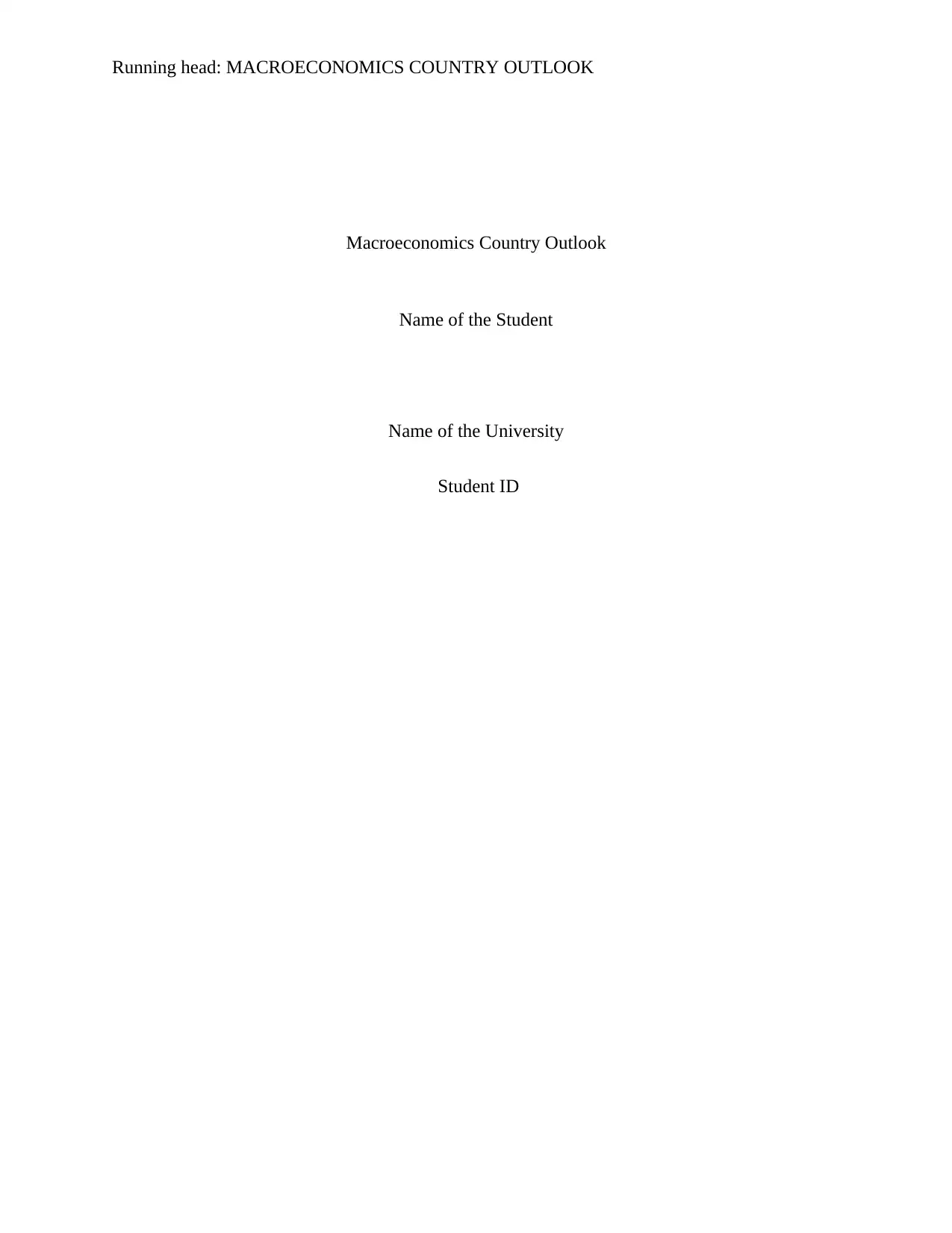
Running head: MACROECONOMICS COUNTRY OUTLOOK
Macroeconomics Country Outlook
Name of the Student
Name of the University
Student ID
Macroeconomics Country Outlook
Name of the Student
Name of the University
Student ID
Paraphrase This Document
Need a fresh take? Get an instant paraphrase of this document with our AI Paraphraser
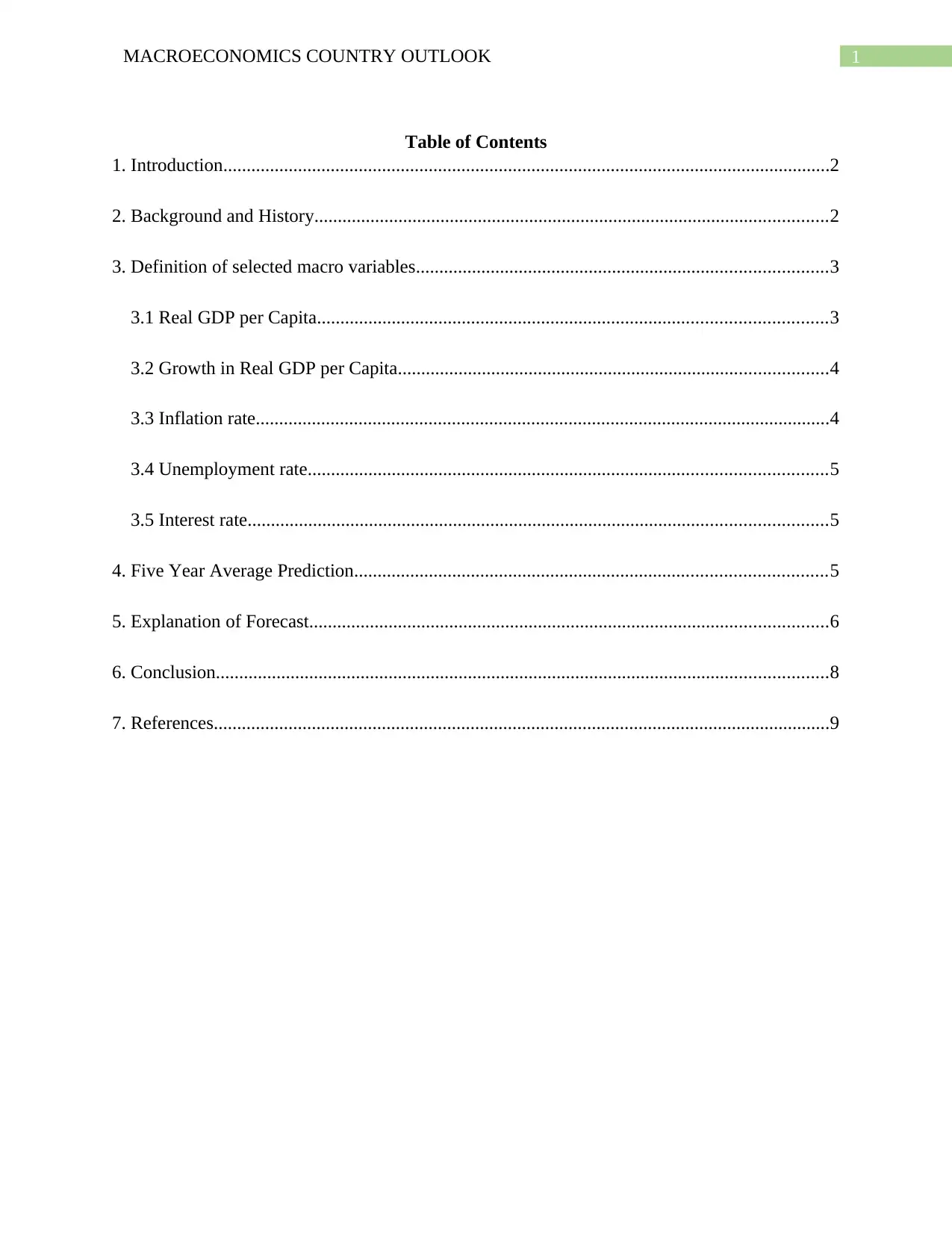
1MACROECONOMICS COUNTRY OUTLOOK
Table of Contents
1. Introduction..................................................................................................................................2
2. Background and History..............................................................................................................2
3. Definition of selected macro variables........................................................................................3
3.1 Real GDP per Capita.............................................................................................................3
3.2 Growth in Real GDP per Capita............................................................................................4
3.3 Inflation rate...........................................................................................................................4
3.4 Unemployment rate...............................................................................................................5
3.5 Interest rate............................................................................................................................5
4. Five Year Average Prediction.....................................................................................................5
5. Explanation of Forecast...............................................................................................................6
6. Conclusion...................................................................................................................................8
7. References....................................................................................................................................9
Table of Contents
1. Introduction..................................................................................................................................2
2. Background and History..............................................................................................................2
3. Definition of selected macro variables........................................................................................3
3.1 Real GDP per Capita.............................................................................................................3
3.2 Growth in Real GDP per Capita............................................................................................4
3.3 Inflation rate...........................................................................................................................4
3.4 Unemployment rate...............................................................................................................5
3.5 Interest rate............................................................................................................................5
4. Five Year Average Prediction.....................................................................................................5
5. Explanation of Forecast...............................................................................................................6
6. Conclusion...................................................................................................................................8
7. References....................................................................................................................................9
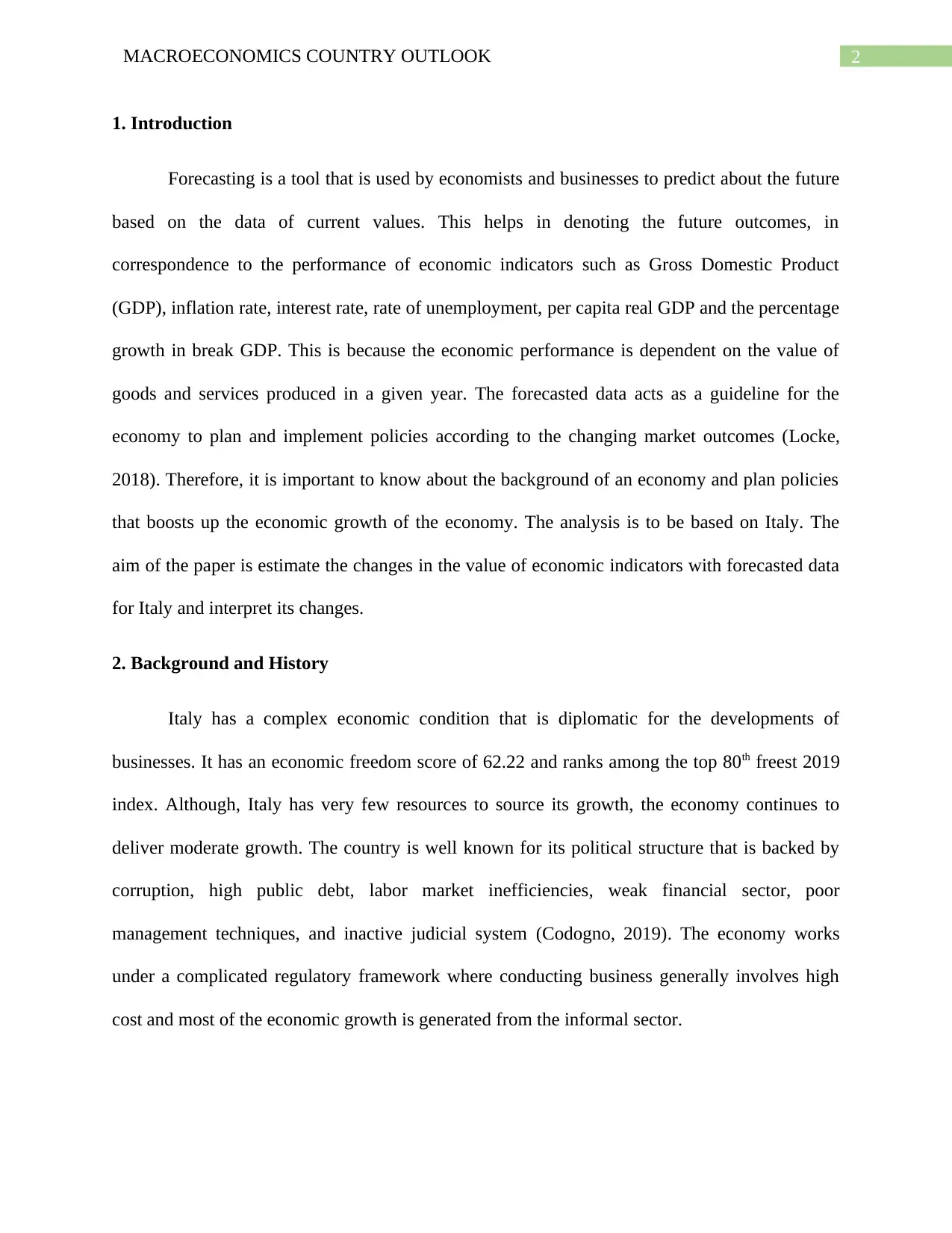
2MACROECONOMICS COUNTRY OUTLOOK
1. Introduction
Forecasting is a tool that is used by economists and businesses to predict about the future
based on the data of current values. This helps in denoting the future outcomes, in
correspondence to the performance of economic indicators such as Gross Domestic Product
(GDP), inflation rate, interest rate, rate of unemployment, per capita real GDP and the percentage
growth in break GDP. This is because the economic performance is dependent on the value of
goods and services produced in a given year. The forecasted data acts as a guideline for the
economy to plan and implement policies according to the changing market outcomes (Locke,
2018). Therefore, it is important to know about the background of an economy and plan policies
that boosts up the economic growth of the economy. The analysis is to be based on Italy. The
aim of the paper is estimate the changes in the value of economic indicators with forecasted data
for Italy and interpret its changes.
2. Background and History
Italy has a complex economic condition that is diplomatic for the developments of
businesses. It has an economic freedom score of 62.22 and ranks among the top 80th freest 2019
index. Although, Italy has very few resources to source its growth, the economy continues to
deliver moderate growth. The country is well known for its political structure that is backed by
corruption, high public debt, labor market inefficiencies, weak financial sector, poor
management techniques, and inactive judicial system (Codogno, 2019). The economy works
under a complicated regulatory framework where conducting business generally involves high
cost and most of the economic growth is generated from the informal sector.
1. Introduction
Forecasting is a tool that is used by economists and businesses to predict about the future
based on the data of current values. This helps in denoting the future outcomes, in
correspondence to the performance of economic indicators such as Gross Domestic Product
(GDP), inflation rate, interest rate, rate of unemployment, per capita real GDP and the percentage
growth in break GDP. This is because the economic performance is dependent on the value of
goods and services produced in a given year. The forecasted data acts as a guideline for the
economy to plan and implement policies according to the changing market outcomes (Locke,
2018). Therefore, it is important to know about the background of an economy and plan policies
that boosts up the economic growth of the economy. The analysis is to be based on Italy. The
aim of the paper is estimate the changes in the value of economic indicators with forecasted data
for Italy and interpret its changes.
2. Background and History
Italy has a complex economic condition that is diplomatic for the developments of
businesses. It has an economic freedom score of 62.22 and ranks among the top 80th freest 2019
index. Although, Italy has very few resources to source its growth, the economy continues to
deliver moderate growth. The country is well known for its political structure that is backed by
corruption, high public debt, labor market inefficiencies, weak financial sector, poor
management techniques, and inactive judicial system (Codogno, 2019). The economy works
under a complicated regulatory framework where conducting business generally involves high
cost and most of the economic growth is generated from the informal sector.
⊘ This is a preview!⊘
Do you want full access?
Subscribe today to unlock all pages.

Trusted by 1+ million students worldwide
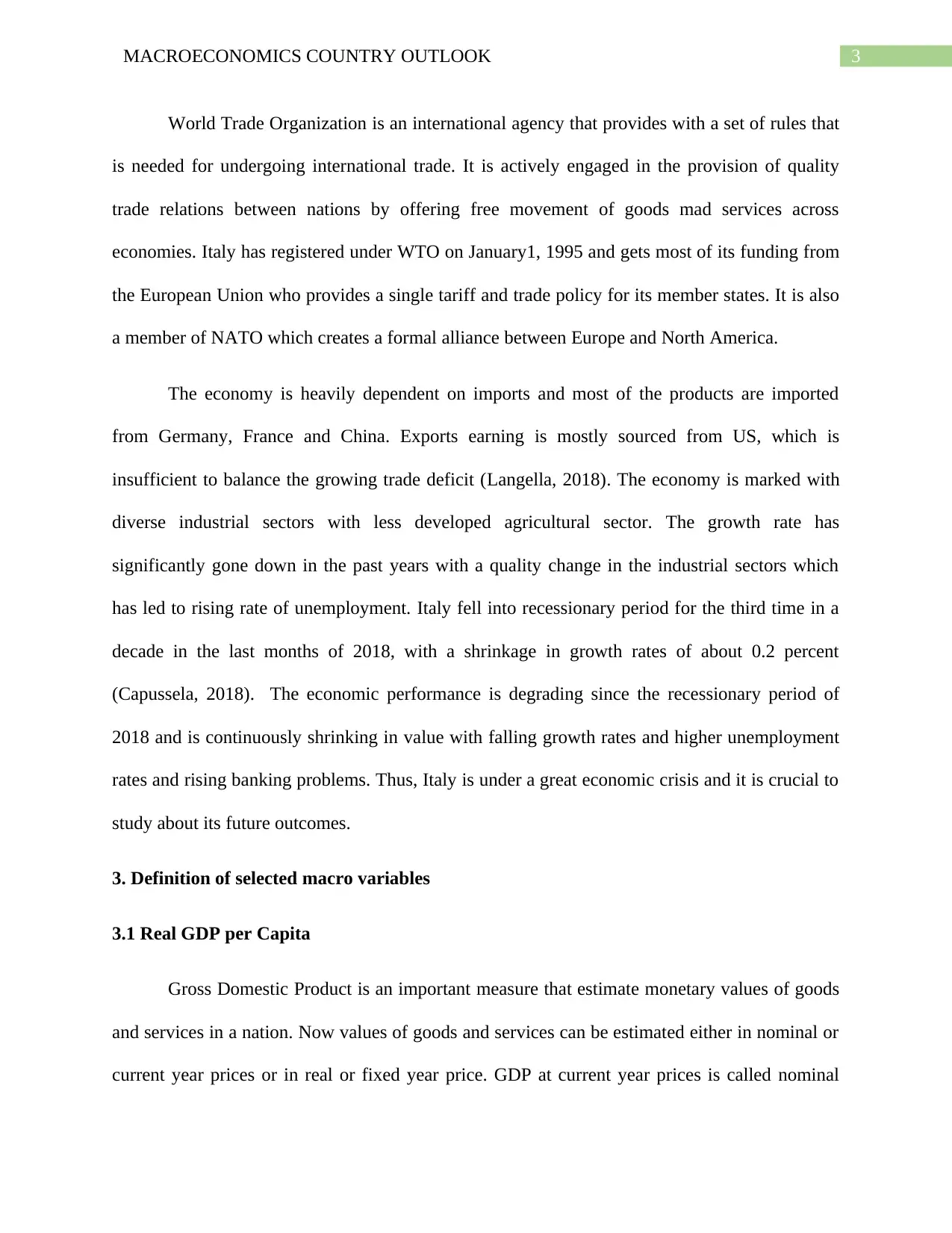
3MACROECONOMICS COUNTRY OUTLOOK
World Trade Organization is an international agency that provides with a set of rules that
is needed for undergoing international trade. It is actively engaged in the provision of quality
trade relations between nations by offering free movement of goods mad services across
economies. Italy has registered under WTO on January1, 1995 and gets most of its funding from
the European Union who provides a single tariff and trade policy for its member states. It is also
a member of NATO which creates a formal alliance between Europe and North America.
The economy is heavily dependent on imports and most of the products are imported
from Germany, France and China. Exports earning is mostly sourced from US, which is
insufficient to balance the growing trade deficit (Langella, 2018). The economy is marked with
diverse industrial sectors with less developed agricultural sector. The growth rate has
significantly gone down in the past years with a quality change in the industrial sectors which
has led to rising rate of unemployment. Italy fell into recessionary period for the third time in a
decade in the last months of 2018, with a shrinkage in growth rates of about 0.2 percent
(Capussela, 2018). The economic performance is degrading since the recessionary period of
2018 and is continuously shrinking in value with falling growth rates and higher unemployment
rates and rising banking problems. Thus, Italy is under a great economic crisis and it is crucial to
study about its future outcomes.
3. Definition of selected macro variables
3.1 Real GDP per Capita
Gross Domestic Product is an important measure that estimate monetary values of goods
and services in a nation. Now values of goods and services can be estimated either in nominal or
current year prices or in real or fixed year price. GDP at current year prices is called nominal
World Trade Organization is an international agency that provides with a set of rules that
is needed for undergoing international trade. It is actively engaged in the provision of quality
trade relations between nations by offering free movement of goods mad services across
economies. Italy has registered under WTO on January1, 1995 and gets most of its funding from
the European Union who provides a single tariff and trade policy for its member states. It is also
a member of NATO which creates a formal alliance between Europe and North America.
The economy is heavily dependent on imports and most of the products are imported
from Germany, France and China. Exports earning is mostly sourced from US, which is
insufficient to balance the growing trade deficit (Langella, 2018). The economy is marked with
diverse industrial sectors with less developed agricultural sector. The growth rate has
significantly gone down in the past years with a quality change in the industrial sectors which
has led to rising rate of unemployment. Italy fell into recessionary period for the third time in a
decade in the last months of 2018, with a shrinkage in growth rates of about 0.2 percent
(Capussela, 2018). The economic performance is degrading since the recessionary period of
2018 and is continuously shrinking in value with falling growth rates and higher unemployment
rates and rising banking problems. Thus, Italy is under a great economic crisis and it is crucial to
study about its future outcomes.
3. Definition of selected macro variables
3.1 Real GDP per Capita
Gross Domestic Product is an important measure that estimate monetary values of goods
and services in a nation. Now values of goods and services can be estimated either in nominal or
current year prices or in real or fixed year price. GDP at current year prices is called nominal
Paraphrase This Document
Need a fresh take? Get an instant paraphrase of this document with our AI Paraphraser
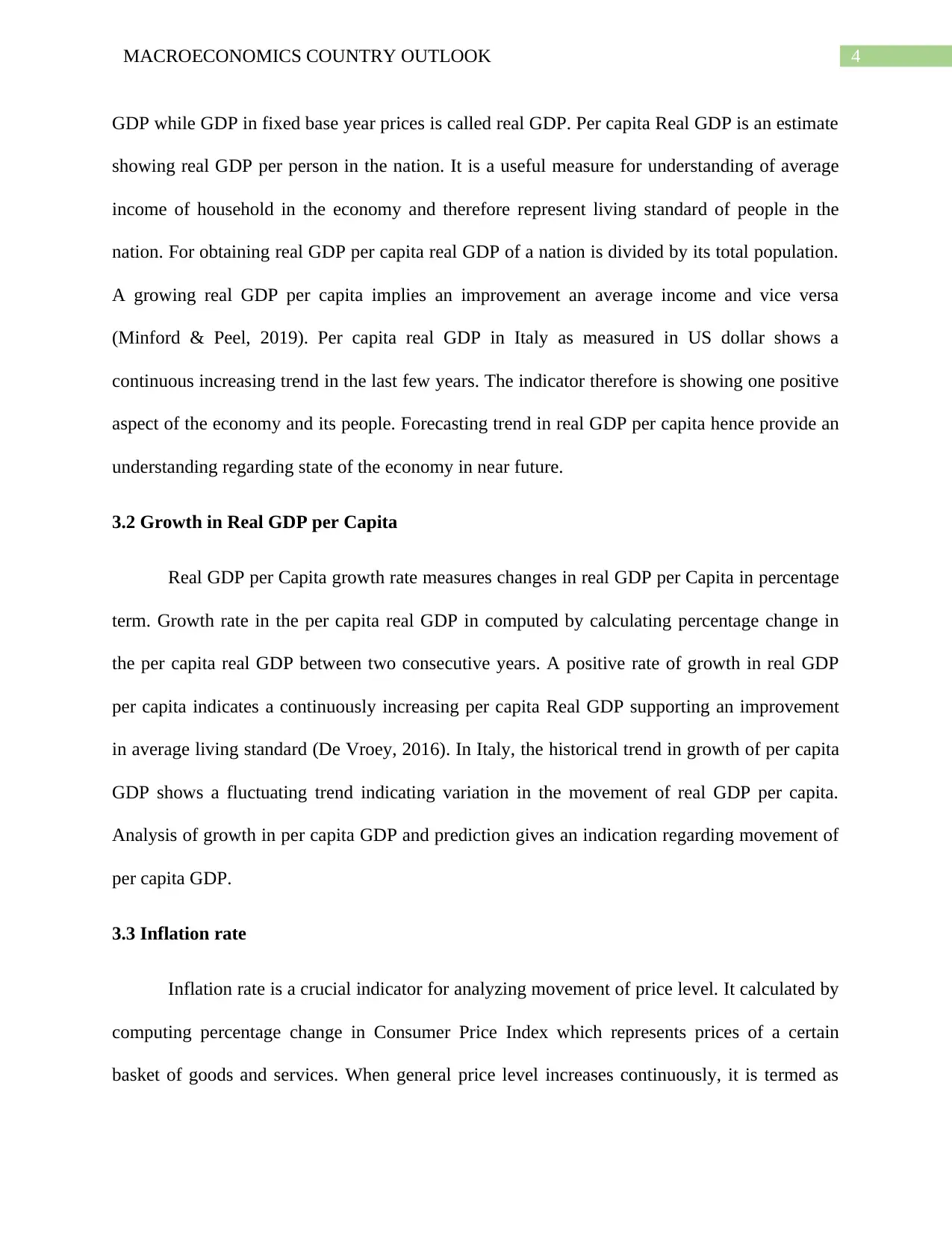
4MACROECONOMICS COUNTRY OUTLOOK
GDP while GDP in fixed base year prices is called real GDP. Per capita Real GDP is an estimate
showing real GDP per person in the nation. It is a useful measure for understanding of average
income of household in the economy and therefore represent living standard of people in the
nation. For obtaining real GDP per capita real GDP of a nation is divided by its total population.
A growing real GDP per capita implies an improvement an average income and vice versa
(Minford & Peel, 2019). Per capita real GDP in Italy as measured in US dollar shows a
continuous increasing trend in the last few years. The indicator therefore is showing one positive
aspect of the economy and its people. Forecasting trend in real GDP per capita hence provide an
understanding regarding state of the economy in near future.
3.2 Growth in Real GDP per Capita
Real GDP per Capita growth rate measures changes in real GDP per Capita in percentage
term. Growth rate in the per capita real GDP in computed by calculating percentage change in
the per capita real GDP between two consecutive years. A positive rate of growth in real GDP
per capita indicates a continuously increasing per capita Real GDP supporting an improvement
in average living standard (De Vroey, 2016). In Italy, the historical trend in growth of per capita
GDP shows a fluctuating trend indicating variation in the movement of real GDP per capita.
Analysis of growth in per capita GDP and prediction gives an indication regarding movement of
per capita GDP.
3.3 Inflation rate
Inflation rate is a crucial indicator for analyzing movement of price level. It calculated by
computing percentage change in Consumer Price Index which represents prices of a certain
basket of goods and services. When general price level increases continuously, it is termed as
GDP while GDP in fixed base year prices is called real GDP. Per capita Real GDP is an estimate
showing real GDP per person in the nation. It is a useful measure for understanding of average
income of household in the economy and therefore represent living standard of people in the
nation. For obtaining real GDP per capita real GDP of a nation is divided by its total population.
A growing real GDP per capita implies an improvement an average income and vice versa
(Minford & Peel, 2019). Per capita real GDP in Italy as measured in US dollar shows a
continuous increasing trend in the last few years. The indicator therefore is showing one positive
aspect of the economy and its people. Forecasting trend in real GDP per capita hence provide an
understanding regarding state of the economy in near future.
3.2 Growth in Real GDP per Capita
Real GDP per Capita growth rate measures changes in real GDP per Capita in percentage
term. Growth rate in the per capita real GDP in computed by calculating percentage change in
the per capita real GDP between two consecutive years. A positive rate of growth in real GDP
per capita indicates a continuously increasing per capita Real GDP supporting an improvement
in average living standard (De Vroey, 2016). In Italy, the historical trend in growth of per capita
GDP shows a fluctuating trend indicating variation in the movement of real GDP per capita.
Analysis of growth in per capita GDP and prediction gives an indication regarding movement of
per capita GDP.
3.3 Inflation rate
Inflation rate is a crucial indicator for analyzing movement of price level. It calculated by
computing percentage change in Consumer Price Index which represents prices of a certain
basket of goods and services. When general price level increases continuously, it is termed as
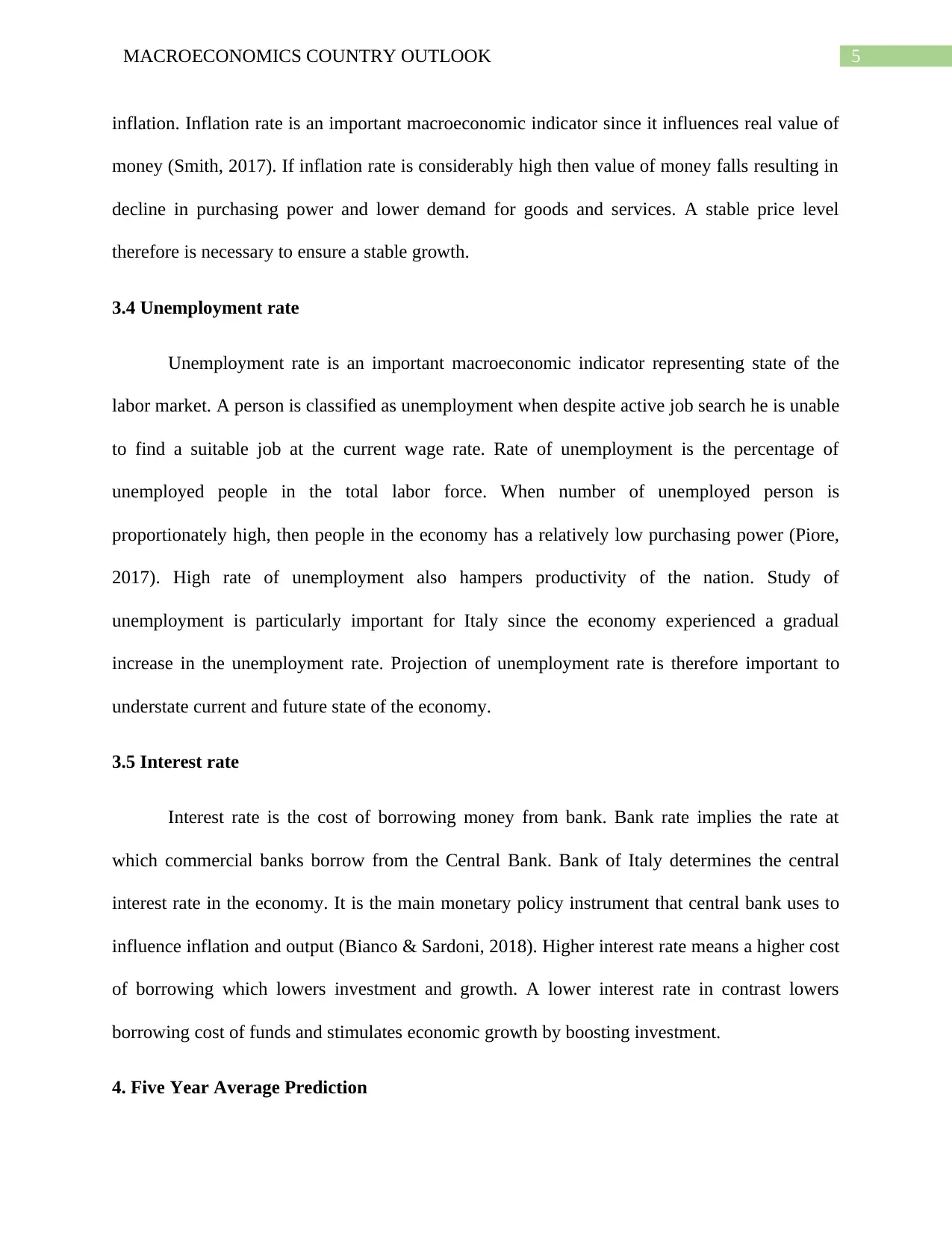
5MACROECONOMICS COUNTRY OUTLOOK
inflation. Inflation rate is an important macroeconomic indicator since it influences real value of
money (Smith, 2017). If inflation rate is considerably high then value of money falls resulting in
decline in purchasing power and lower demand for goods and services. A stable price level
therefore is necessary to ensure a stable growth.
3.4 Unemployment rate
Unemployment rate is an important macroeconomic indicator representing state of the
labor market. A person is classified as unemployment when despite active job search he is unable
to find a suitable job at the current wage rate. Rate of unemployment is the percentage of
unemployed people in the total labor force. When number of unemployed person is
proportionately high, then people in the economy has a relatively low purchasing power (Piore,
2017). High rate of unemployment also hampers productivity of the nation. Study of
unemployment is particularly important for Italy since the economy experienced a gradual
increase in the unemployment rate. Projection of unemployment rate is therefore important to
understate current and future state of the economy.
3.5 Interest rate
Interest rate is the cost of borrowing money from bank. Bank rate implies the rate at
which commercial banks borrow from the Central Bank. Bank of Italy determines the central
interest rate in the economy. It is the main monetary policy instrument that central bank uses to
influence inflation and output (Bianco & Sardoni, 2018). Higher interest rate means a higher cost
of borrowing which lowers investment and growth. A lower interest rate in contrast lowers
borrowing cost of funds and stimulates economic growth by boosting investment.
4. Five Year Average Prediction
inflation. Inflation rate is an important macroeconomic indicator since it influences real value of
money (Smith, 2017). If inflation rate is considerably high then value of money falls resulting in
decline in purchasing power and lower demand for goods and services. A stable price level
therefore is necessary to ensure a stable growth.
3.4 Unemployment rate
Unemployment rate is an important macroeconomic indicator representing state of the
labor market. A person is classified as unemployment when despite active job search he is unable
to find a suitable job at the current wage rate. Rate of unemployment is the percentage of
unemployed people in the total labor force. When number of unemployed person is
proportionately high, then people in the economy has a relatively low purchasing power (Piore,
2017). High rate of unemployment also hampers productivity of the nation. Study of
unemployment is particularly important for Italy since the economy experienced a gradual
increase in the unemployment rate. Projection of unemployment rate is therefore important to
understate current and future state of the economy.
3.5 Interest rate
Interest rate is the cost of borrowing money from bank. Bank rate implies the rate at
which commercial banks borrow from the Central Bank. Bank of Italy determines the central
interest rate in the economy. It is the main monetary policy instrument that central bank uses to
influence inflation and output (Bianco & Sardoni, 2018). Higher interest rate means a higher cost
of borrowing which lowers investment and growth. A lower interest rate in contrast lowers
borrowing cost of funds and stimulates economic growth by boosting investment.
4. Five Year Average Prediction
⊘ This is a preview!⊘
Do you want full access?
Subscribe today to unlock all pages.

Trusted by 1+ million students worldwide
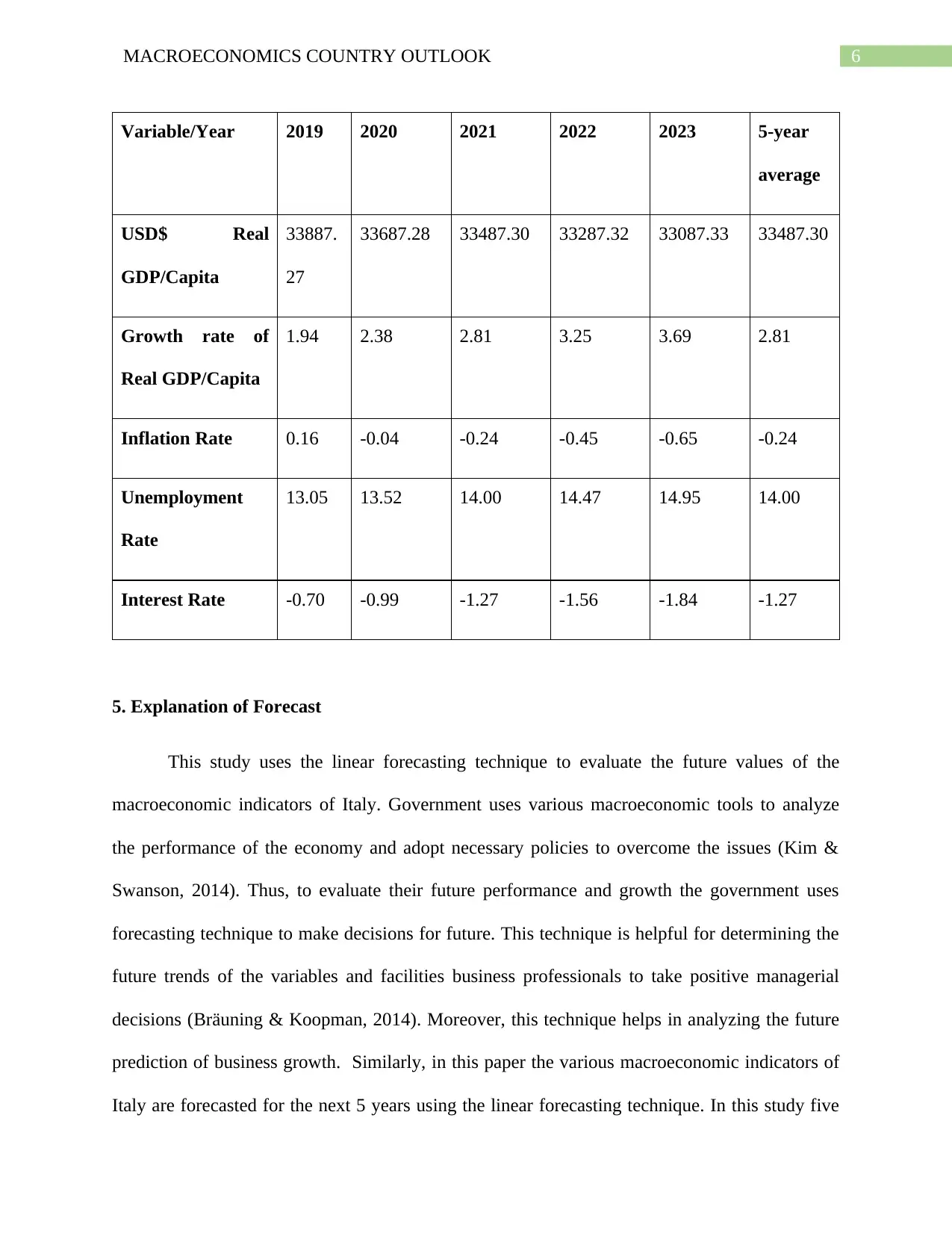
6MACROECONOMICS COUNTRY OUTLOOK
Variable/Year 2019 2020 2021 2022 2023 5-year
average
USD$ Real
GDP/Capita
33887.
27
33687.28 33487.30 33287.32 33087.33 33487.30
Growth rate of
Real GDP/Capita
1.94 2.38 2.81 3.25 3.69 2.81
Inflation Rate 0.16 -0.04 -0.24 -0.45 -0.65 -0.24
Unemployment
Rate
13.05 13.52 14.00 14.47 14.95 14.00
Interest Rate -0.70 -0.99 -1.27 -1.56 -1.84 -1.27
5. Explanation of Forecast
This study uses the linear forecasting technique to evaluate the future values of the
macroeconomic indicators of Italy. Government uses various macroeconomic tools to analyze
the performance of the economy and adopt necessary policies to overcome the issues (Kim &
Swanson, 2014). Thus, to evaluate their future performance and growth the government uses
forecasting technique to make decisions for future. This technique is helpful for determining the
future trends of the variables and facilities business professionals to take positive managerial
decisions (Bräuning & Koopman, 2014). Moreover, this technique helps in analyzing the future
prediction of business growth. Similarly, in this paper the various macroeconomic indicators of
Italy are forecasted for the next 5 years using the linear forecasting technique. In this study five
Variable/Year 2019 2020 2021 2022 2023 5-year
average
USD$ Real
GDP/Capita
33887.
27
33687.28 33487.30 33287.32 33087.33 33487.30
Growth rate of
Real GDP/Capita
1.94 2.38 2.81 3.25 3.69 2.81
Inflation Rate 0.16 -0.04 -0.24 -0.45 -0.65 -0.24
Unemployment
Rate
13.05 13.52 14.00 14.47 14.95 14.00
Interest Rate -0.70 -0.99 -1.27 -1.56 -1.84 -1.27
5. Explanation of Forecast
This study uses the linear forecasting technique to evaluate the future values of the
macroeconomic indicators of Italy. Government uses various macroeconomic tools to analyze
the performance of the economy and adopt necessary policies to overcome the issues (Kim &
Swanson, 2014). Thus, to evaluate their future performance and growth the government uses
forecasting technique to make decisions for future. This technique is helpful for determining the
future trends of the variables and facilities business professionals to take positive managerial
decisions (Bräuning & Koopman, 2014). Moreover, this technique helps in analyzing the future
prediction of business growth. Similarly, in this paper the various macroeconomic indicators of
Italy are forecasted for the next 5 years using the linear forecasting technique. In this study five
Paraphrase This Document
Need a fresh take? Get an instant paraphrase of this document with our AI Paraphraser
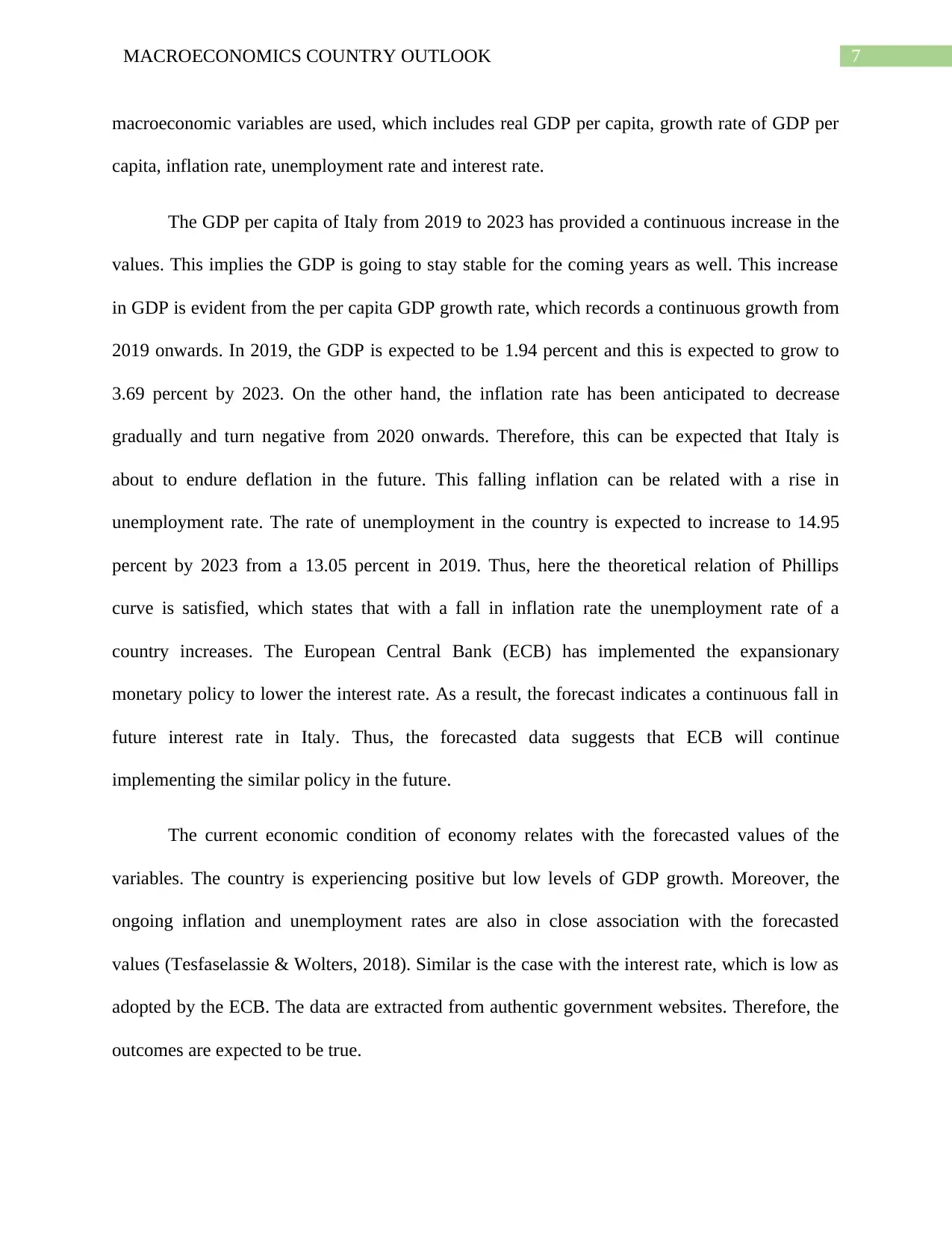
7MACROECONOMICS COUNTRY OUTLOOK
macroeconomic variables are used, which includes real GDP per capita, growth rate of GDP per
capita, inflation rate, unemployment rate and interest rate.
The GDP per capita of Italy from 2019 to 2023 has provided a continuous increase in the
values. This implies the GDP is going to stay stable for the coming years as well. This increase
in GDP is evident from the per capita GDP growth rate, which records a continuous growth from
2019 onwards. In 2019, the GDP is expected to be 1.94 percent and this is expected to grow to
3.69 percent by 2023. On the other hand, the inflation rate has been anticipated to decrease
gradually and turn negative from 2020 onwards. Therefore, this can be expected that Italy is
about to endure deflation in the future. This falling inflation can be related with a rise in
unemployment rate. The rate of unemployment in the country is expected to increase to 14.95
percent by 2023 from a 13.05 percent in 2019. Thus, here the theoretical relation of Phillips
curve is satisfied, which states that with a fall in inflation rate the unemployment rate of a
country increases. The European Central Bank (ECB) has implemented the expansionary
monetary policy to lower the interest rate. As a result, the forecast indicates a continuous fall in
future interest rate in Italy. Thus, the forecasted data suggests that ECB will continue
implementing the similar policy in the future.
The current economic condition of economy relates with the forecasted values of the
variables. The country is experiencing positive but low levels of GDP growth. Moreover, the
ongoing inflation and unemployment rates are also in close association with the forecasted
values (Tesfaselassie & Wolters, 2018). Similar is the case with the interest rate, which is low as
adopted by the ECB. The data are extracted from authentic government websites. Therefore, the
outcomes are expected to be true.
macroeconomic variables are used, which includes real GDP per capita, growth rate of GDP per
capita, inflation rate, unemployment rate and interest rate.
The GDP per capita of Italy from 2019 to 2023 has provided a continuous increase in the
values. This implies the GDP is going to stay stable for the coming years as well. This increase
in GDP is evident from the per capita GDP growth rate, which records a continuous growth from
2019 onwards. In 2019, the GDP is expected to be 1.94 percent and this is expected to grow to
3.69 percent by 2023. On the other hand, the inflation rate has been anticipated to decrease
gradually and turn negative from 2020 onwards. Therefore, this can be expected that Italy is
about to endure deflation in the future. This falling inflation can be related with a rise in
unemployment rate. The rate of unemployment in the country is expected to increase to 14.95
percent by 2023 from a 13.05 percent in 2019. Thus, here the theoretical relation of Phillips
curve is satisfied, which states that with a fall in inflation rate the unemployment rate of a
country increases. The European Central Bank (ECB) has implemented the expansionary
monetary policy to lower the interest rate. As a result, the forecast indicates a continuous fall in
future interest rate in Italy. Thus, the forecasted data suggests that ECB will continue
implementing the similar policy in the future.
The current economic condition of economy relates with the forecasted values of the
variables. The country is experiencing positive but low levels of GDP growth. Moreover, the
ongoing inflation and unemployment rates are also in close association with the forecasted
values (Tesfaselassie & Wolters, 2018). Similar is the case with the interest rate, which is low as
adopted by the ECB. The data are extracted from authentic government websites. Therefore, the
outcomes are expected to be true.
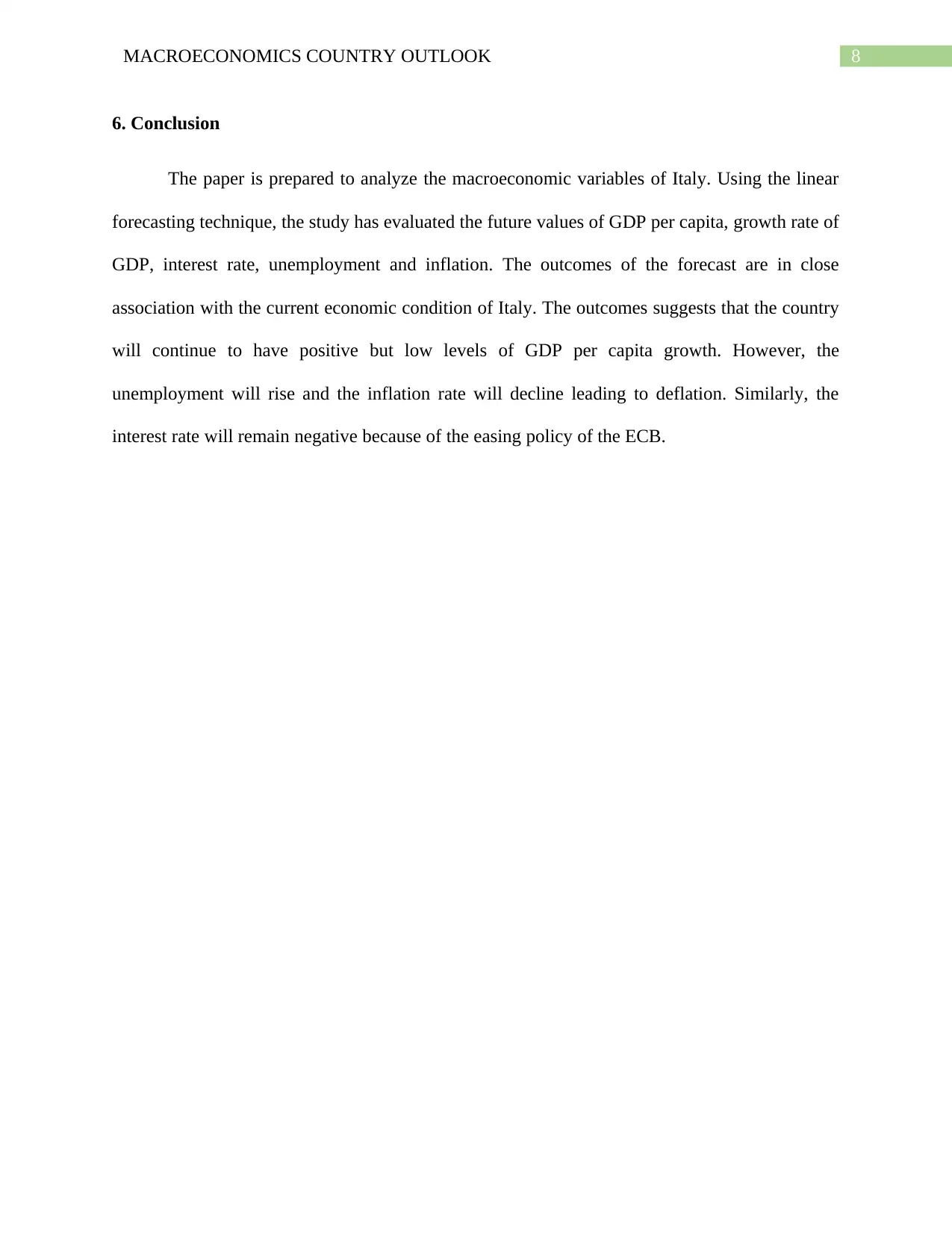
8MACROECONOMICS COUNTRY OUTLOOK
6. Conclusion
The paper is prepared to analyze the macroeconomic variables of Italy. Using the linear
forecasting technique, the study has evaluated the future values of GDP per capita, growth rate of
GDP, interest rate, unemployment and inflation. The outcomes of the forecast are in close
association with the current economic condition of Italy. The outcomes suggests that the country
will continue to have positive but low levels of GDP per capita growth. However, the
unemployment will rise and the inflation rate will decline leading to deflation. Similarly, the
interest rate will remain negative because of the easing policy of the ECB.
6. Conclusion
The paper is prepared to analyze the macroeconomic variables of Italy. Using the linear
forecasting technique, the study has evaluated the future values of GDP per capita, growth rate of
GDP, interest rate, unemployment and inflation. The outcomes of the forecast are in close
association with the current economic condition of Italy. The outcomes suggests that the country
will continue to have positive but low levels of GDP per capita growth. However, the
unemployment will rise and the inflation rate will decline leading to deflation. Similarly, the
interest rate will remain negative because of the easing policy of the ECB.
⊘ This is a preview!⊘
Do you want full access?
Subscribe today to unlock all pages.

Trusted by 1+ million students worldwide
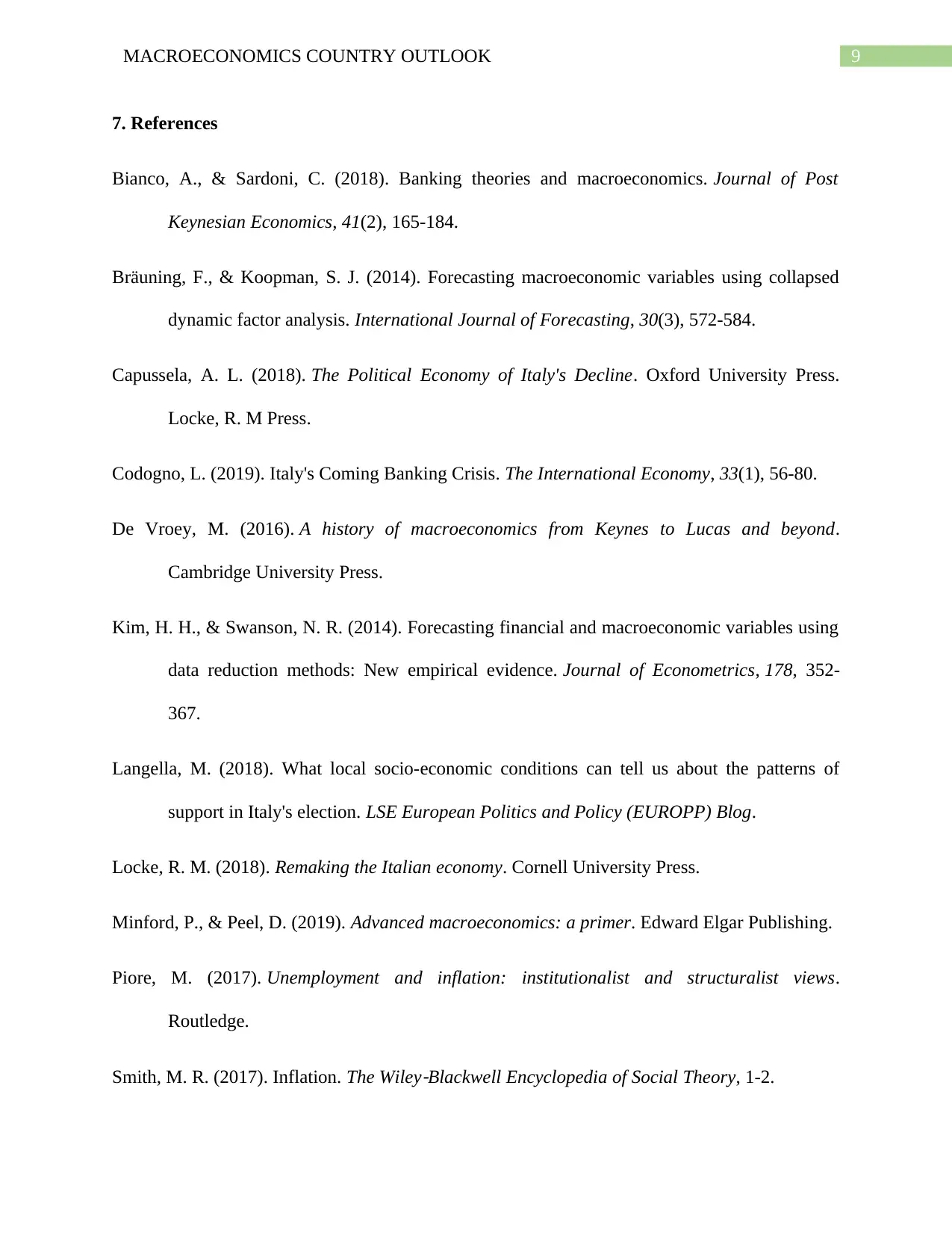
9MACROECONOMICS COUNTRY OUTLOOK
7. References
Bianco, A., & Sardoni, C. (2018). Banking theories and macroeconomics. Journal of Post
Keynesian Economics, 41(2), 165-184.
Bräuning, F., & Koopman, S. J. (2014). Forecasting macroeconomic variables using collapsed
dynamic factor analysis. International Journal of Forecasting, 30(3), 572-584.
Capussela, A. L. (2018). The Political Economy of Italy's Decline. Oxford University Press.
Locke, R. M Press.
Codogno, L. (2019). Italy's Coming Banking Crisis. The International Economy, 33(1), 56-80.
De Vroey, M. (2016). A history of macroeconomics from Keynes to Lucas and beyond.
Cambridge University Press.
Kim, H. H., & Swanson, N. R. (2014). Forecasting financial and macroeconomic variables using
data reduction methods: New empirical evidence. Journal of Econometrics, 178, 352-
367.
Langella, M. (2018). What local socio-economic conditions can tell us about the patterns of
support in Italy's election. LSE European Politics and Policy (EUROPP) Blog.
Locke, R. M. (2018). Remaking the Italian economy. Cornell University Press.
Minford, P., & Peel, D. (2019). Advanced macroeconomics: a primer. Edward Elgar Publishing.
Piore, M. (2017). Unemployment and inflation: institutionalist and structuralist views.
Routledge.
Smith, M. R. (2017). Inflation. The Wiley
‐Blackwell Encyclopedia of Social Theory, 1-2.
7. References
Bianco, A., & Sardoni, C. (2018). Banking theories and macroeconomics. Journal of Post
Keynesian Economics, 41(2), 165-184.
Bräuning, F., & Koopman, S. J. (2014). Forecasting macroeconomic variables using collapsed
dynamic factor analysis. International Journal of Forecasting, 30(3), 572-584.
Capussela, A. L. (2018). The Political Economy of Italy's Decline. Oxford University Press.
Locke, R. M Press.
Codogno, L. (2019). Italy's Coming Banking Crisis. The International Economy, 33(1), 56-80.
De Vroey, M. (2016). A history of macroeconomics from Keynes to Lucas and beyond.
Cambridge University Press.
Kim, H. H., & Swanson, N. R. (2014). Forecasting financial and macroeconomic variables using
data reduction methods: New empirical evidence. Journal of Econometrics, 178, 352-
367.
Langella, M. (2018). What local socio-economic conditions can tell us about the patterns of
support in Italy's election. LSE European Politics and Policy (EUROPP) Blog.
Locke, R. M. (2018). Remaking the Italian economy. Cornell University Press.
Minford, P., & Peel, D. (2019). Advanced macroeconomics: a primer. Edward Elgar Publishing.
Piore, M. (2017). Unemployment and inflation: institutionalist and structuralist views.
Routledge.
Smith, M. R. (2017). Inflation. The Wiley
‐Blackwell Encyclopedia of Social Theory, 1-2.
Paraphrase This Document
Need a fresh take? Get an instant paraphrase of this document with our AI Paraphraser
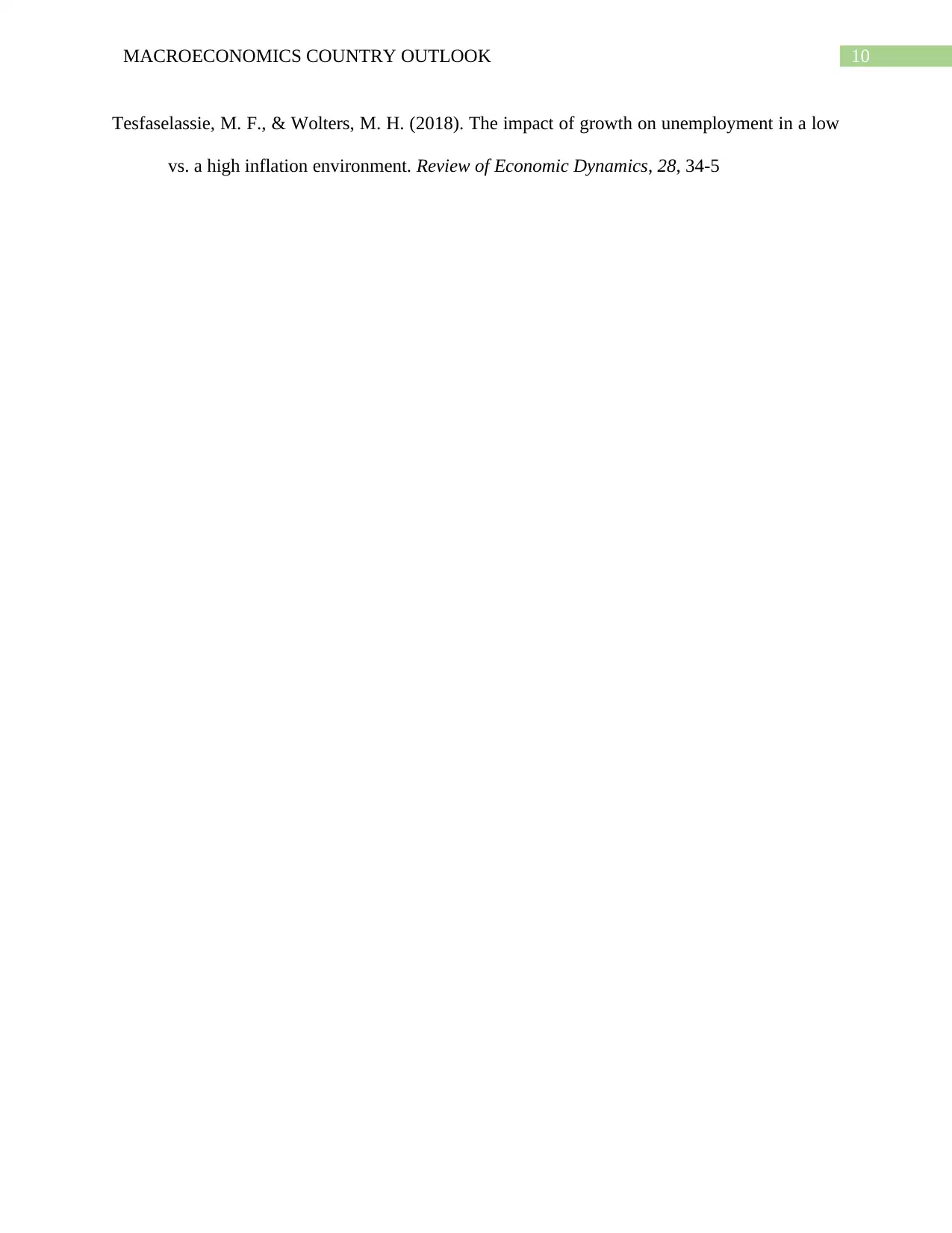
10MACROECONOMICS COUNTRY OUTLOOK
Tesfaselassie, M. F., & Wolters, M. H. (2018). The impact of growth on unemployment in a low
vs. a high inflation environment. Review of Economic Dynamics, 28, 34-5
Tesfaselassie, M. F., & Wolters, M. H. (2018). The impact of growth on unemployment in a low
vs. a high inflation environment. Review of Economic Dynamics, 28, 34-5
1 out of 11
Related Documents
Your All-in-One AI-Powered Toolkit for Academic Success.
+13062052269
info@desklib.com
Available 24*7 on WhatsApp / Email
![[object Object]](/_next/static/media/star-bottom.7253800d.svg)
Unlock your academic potential
Copyright © 2020–2025 A2Z Services. All Rights Reserved. Developed and managed by ZUCOL.



